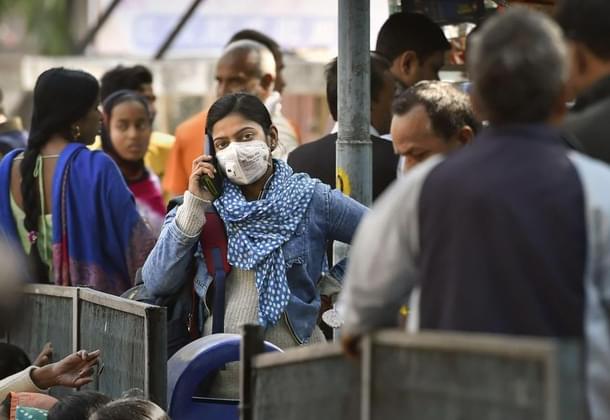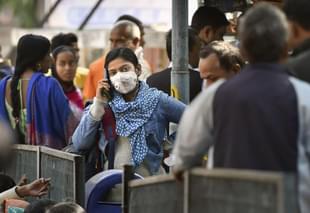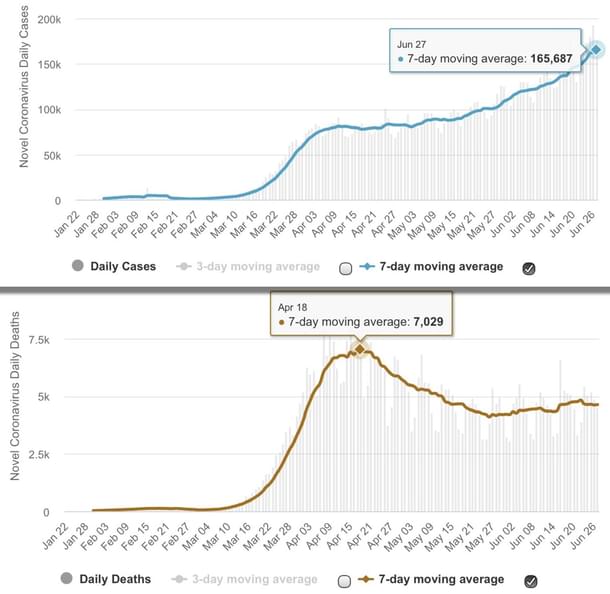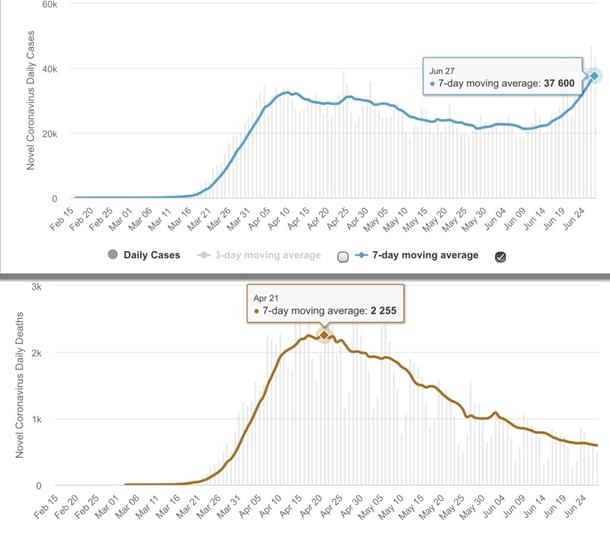Ideas
Data Shows Coronavirus Is Becoming Less Deadly: This Is Final Evidence We Need To Declare Modi‘s Lockdown Strategy A Success
Arihant Pawariya
Jun 28, 2020, 12:33 PM | Updated 12:33 PM IST
Save & read from anywhere!
Bookmark stories for easy access on any device or the Swarajya app.


What is a leader of a country supposed to do when faced with an invasion by an unknown and unpredictable lethal enemy that is crossing the border quickly?
The wise one would order the unprepared troops on the border to fall back to more secure locations, buy some time to asses the enemy’s strengths and weaknesses and prepare yourself to take it on more effectively.
The stupid one will order its frontline troops to confront the enemy unprepared and get them killed, making further invasion by the enemy smooth and easy.
Narendra Modi as India’s Prime Minister did the former when faced with the prospect of attack by the novel coronavirus in March. He announced a nationwide lockdown when the total number of cases of Covid-19, the disease caused by the virus, were less than 500.
Three months later, while the country has largely opened up slowly and in stages, some controls still remain (and rightly so) which disallow large-scale gatherings.
During lockdowns, India managed to ramp up its testing capacity many times by increasing the total number of labs from two in March to more than 1,000 today.
In March, India didn’t produce any Personal Protective Equipment (PPE) kits or masks and was staring at the prospect of buying cheap Chinese knockoff.
Now, it produces lakhs of PPE kits and masks per day and is looking to start exporting them.
Moreover, it is in the process of supplying 50,000 odd ‘Made in India’ ventilators to the country’s hospitals.
To put it in perspective, the current ventilator capacity in the country is less than that number.
Essentially, India took the time to understand the nature of the virus and equip itself to fight it more effectively.
However, Rahul Gandhi has been criticising “the man in the arena” for putting India under lockdown and calling this strategy a ‘failure’ because it didn’t check the spread of the virus.
While the goal in the beginning may have been to crush the curve of daily new cases, Gandhi should understand that this was made impossible by the recklessly Tablighi Jamaat members who spread the virus in their communities across the country and which, in turn, behaved equally irresponsibly and hid the disease and spread it in whole cities.
But Gandhi would only highlight the end result and not the cause of that.
Nonetheless, given India’s unpreparedness in March, going for early lockdown was actually a no-brainier.
But even no-brainier decisions require a little mental effort to grasp and execute.
Now, data shows that the novel coronavirus is becoming less deadly as it is ripping through more and more populations across the world.
With time, the virus seems to be losing its potency.
In April, the virus took just 15 days to claim one lakh lives.
In June, it took 22.
The two graphs in the picture below show the number of daily cases and the number of daily deaths with green and dark brown curves depicting seven-day moving average for new cases and new deaths respectively.
It tells us that while the number of daily cases are steadily increasing (7-day moving average on 27 June stood at 165,687), the number of daily new deaths is on the decline (the peak was in mid-April — 7,029 on 18 April, a number which has come down to 4,630 as of yesterday).

Even in the United States, which is seeing a second wave of infections thanks to large-scale protests across the country and states reopening quickly, the number of daily deaths are way lower than what they were back in April.
The graphs below shows the daily new cases and daily new deaths.
As one can see, the US is registering its highest ever daily cases tally, a record which it is breaking almost daily these days.
However, daily deaths are many times lower than what they were in April when the daily cases were significantly lower compared to what they have been in the past one week.
Seven-day moving average of daily new cases reached 37,600 (highest ever) in the US yesterday (27 June) while the same for new deaths had peaked on 21 April (2,255) and reached 594 on 27 June.

Of the top countries with most number of deaths, daily deaths are increasing only in those nations (like India and Brazil), which have not seen their peak of daily deaths yet.
However, mortality rates in both these countries is 3-4 times lower than what was witnessed in countries like the United Kingdom, Italy and Spain, which were hit the worst in the initial phase.
Two Italian doctors have come out and said that the novel virus is indeed losing potency.
“The strength the virus had two months ago is not the same strength it has today,” Matteo Bassetti, head of the infectious diseases clinic at the San Martino hospital in the city of Genoa, told Reuters.
Bassetti says the disease today is different from the disease of three months ago.
“The majority of patients who were presented in our emergency rooms or wards during March and April were very sick with acute respiratory distress syndrome, shock, multiple organ failure, and the majority died in the first days after admission. Now in May, we no longer see these types of patients,” he told Elemental, explaining his comment to Reuters.
“The clinical impression here is that the virus is different,” he says.
“Is this because the virus lost some viral potency? Or because the viral load or total count of the virus is lower? I don’t know,” Bassetti added.
Alberto Zangrillo, the head of the San Raffaele Hospital in Milan in the northern region of Lombardy, also voiced similar views.
“The swabs that were performed over the last 10 days showed a viral load in quantitative terms that was absolutely infinitesimal compared to the ones carried out a month or two months ago,” he told RAI television, as reported by Reuters.
However, the World Health Organisation (WHO) and some other experts quickly came forward to counter and refute the views of these two doctors.
But the data is certainly pointing to decreasing daily deaths when the disease is infecting more and more people.
The phenomenon is seen worldwide and even in individual countries like the United States, which is seeing a second wave.
The mortality rate in countries which are witnessing a late surge in spread of infection (like Brazil and India) is also lower compared to those which were hit early and hard.
Though the lockdown was a sound step solely based on the precautionary principle, if the daily deaths are indeed decreasing due to weakening of the virus, this development should be taken as the final evidence to declare the strategy of implementing strict lockdowns early a ‘success’.
Arihant Pawariya is Senior Editor, Swarajya.





